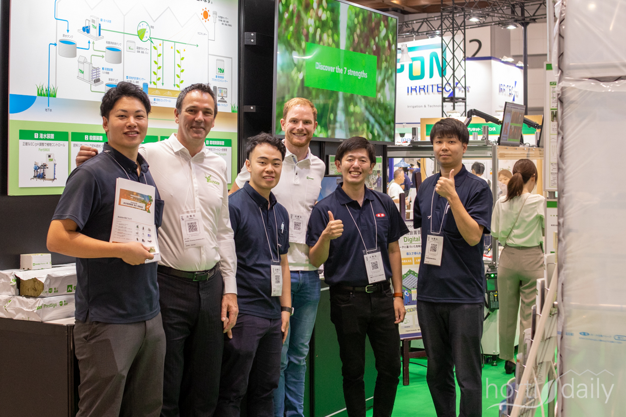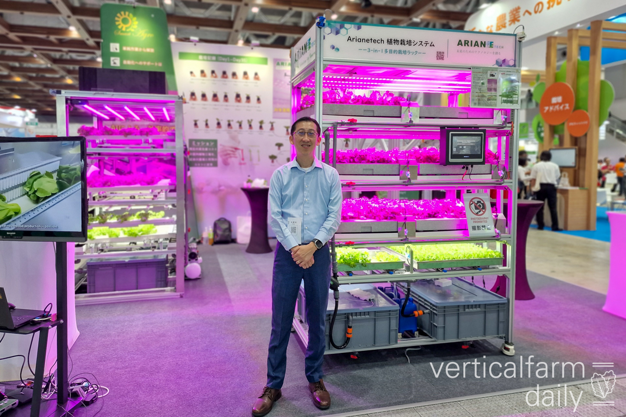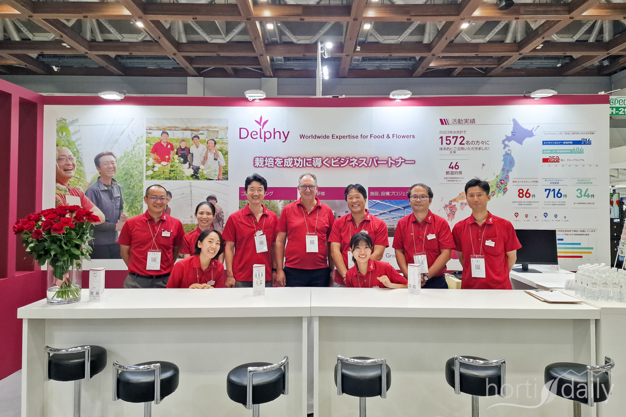"It's great to see a show this size take place in Japan for the horticulture industry," said a US researcher present, commenting on the turnout. Mainly visited by domestic, Korean, and Chinese companies, the GPEC show took place on 24-26 July in Tokyo with just a few international, partnering companies visiting or participating.
Elaborating on the statement, the researcher explained that a horticulture industry like Japan which is still in its infancy, needs exhibitions of 'this size' that offer solutions for smaller-sized operators. "Solutions from overseas are often way too big, expensive, or overcomplicated for what's actually needed. The GPEC offers a lot of opportunities for the local market given many small-, to mid-scale products and solutions are offered."
Click here to view the photo report.

The Priva team present! Priva has seen a lot of interest from Japanese operators as climate change is making it challenging to keep a stable growing environment.
Push for greenhouses
There is a big preference for greenhouses, partially because the government covers 50% of the investment cost when operators decide to construct a greenhouse. Yet, that only applies to plastic-covered facilities, rather than glass. Despite glass being more resistant to heavy storms the country typically faces, growers are not ready to heavily invest in new facilities yet and prefer to go for the short-term solution that will last about five to six years, depending on the supplier.
Despite it being the most affordable option, a massive problem growers are experiencing is cooling the greenhouse. Sometimes temperatures hit 40 degrees Celsius, which is problematic as growers are experiencing a massive hurdle to cool down their facilities. Some suppliers present were showcasing a premium plastic that allows for better insulation inside the greenhouse.
Click here to view the photo report.

Seen with the ZGR team are Guenael Sebillot of Ridder, and Tico van Leeuwen with Grodan
Uncertainty after Covid-19
Many suppliers have said to see a slight comeback in projects after Covid, which has left growers with a very sour after-taste. "The market hasn't fully recovered yet so fewer risks are taken ever since covid wiped out quite some growers. New projects aren't closed that easily as growers are very careful when it comes to making new investments because of the uncertainty," a Japanese supplier let know.
Focus on automation
As you might have guessed, labor is a big issue in Japan as the average age of farming is getting higher by the age. Growers are looking to automate many processes, from seed to harvest. Though, automation is on another level it seems as if most are not fixated on large, high-tech machinery or elaborative conveyor systems. Rather, something functional that suits their facility, often at a reasonable scale to solve their labor issue(s).
Click here to view the photo report.

Edwin Ong with Ariane Tech showcasing their IoT-controlled, automated vertical farming solutions
Energy prices affect
Not only European vertical farmers are hit by the increasing energy cost, but Japanese operators are also affected by it. Trying to minimize the inputs as much as possible to lower the OpEx is the way to go.
Sustainable gas in 2050
When asking around about the sustainability aspect of the greenhouses, many responded by saying that they are going from natural gas to e-boilers as the government is pushing for the use of sustainable gas only by 2050. This results in many growers pivoting to this alternative resource, which is causing a bit of rumbling in the background. Not many seem to be very worried about it, but suppliers are heavily focusing on incorporating this in their all-round solutions.

'Multinationals tapping in'
Notably, big multinationals were present with an agtech venture spinoff, as they all 'are trying to get a slice of the cake'. In general, there's a big focus on providing an all-round solution due to the labor shortages, and the efficiency that is needed to produce year-round as climate change is heavily affecting open field producers. In the week of GPEC, Tokyo reached temperatures of 39 degrees Celsius at high humidity levels, which has never happened before. Therefore, all hope is set on indoor production with a preference for greenhouses given the monetary backing available.
Time to check the photo report and see who was there. If we weren't able to visit your stand or booth, please feel free to send us a photo at [email protected].
